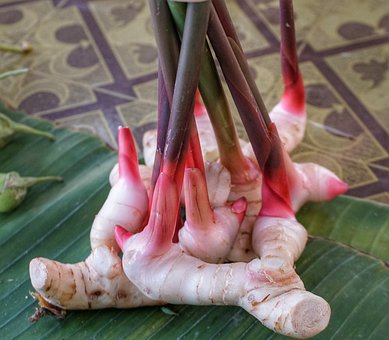 I've used both ginger and galangal in my cooking depending on the recipe. Unfortunately, it is harder for me to find galangal in town so I end up ordering powdered which isn't quite the same.
I've used both ginger and galangal in my cooking depending on the recipe. Unfortunately, it is harder for me to find galangal in town so I end up ordering powdered which isn't quite the same. When I discuss ginger, I'm discussing the root, not the flower. Although they are related, the three cannot be interchanged easily. In addition, one is used more than the other in certain types of cooking. Ginger, galangal and tumeric are rhizomes which means they are parts of shoots sent off to start a new family underground. They are all members of the same family
Ginger is the spice used in Indian cooking and in American pumpkin pies. I usually keep a squeezable bottle of chopped ginger in the refrigerator because I use it so much and it lasts longer. Furthermore, it is not easily ordered in so the squeeze bottle works better. Many dishes such as gingerbread, or ginger beer uses chopped, preserved ginger while in Asian or Indian cooking they use it fresh.
Ginger is known as Zingiber Officinale if you look at it's Latin name. Ginger is harvested once the plant matures and dies. It has a brown skin that is easily taken off by scraping the root with a spoon and a yellowish interior. Furthermore, it is easier to grate than galangal and it's flavor is mildly sweet with a hint of sweetness.
 On the other hand, galangal is also known as Thai or Siamese ginger and is more often used in Indonesian, Malaysian, or Thai cooking. It's skin is browner and knobbier than the ginger's with a whiter interior, and the root cannot be grated since it is too hard so it must be sliced or crushed instead. The flavor is much stronger, earthy, sharper, and has a hint of citrus. Galangal is used to flavor soups or curries but is not usually eaten. If you find galangal in the supermarket, look for a root that is firm without any soft or sunk spots.
On the other hand, galangal is also known as Thai or Siamese ginger and is more often used in Indonesian, Malaysian, or Thai cooking. It's skin is browner and knobbier than the ginger's with a whiter interior, and the root cannot be grated since it is too hard so it must be sliced or crushed instead. The flavor is much stronger, earthy, sharper, and has a hint of citrus. Galangal is used to flavor soups or curries but is not usually eaten. If you find galangal in the supermarket, look for a root that is firm without any soft or sunk spots.There are actually two types of galangal, greater galangal which is often referred to only as galangal or "kha" in the Thai language and comes from Indonesia and Laos while the other is the lesser galangal, labeled lesser galangal or "krachai" in Thai comes from South China. The lesser galangal has a more peppery flavor than the other. Galangal is often found in the red or green curry used in Thai cooking or in dishes with coconut milk. Since galangal is harder to get than ginger, it often is more expensive.
 Tumeric is also known as Indian saffron or false saffron due to it's yellow color that can stain fingers. Tumeric roots are picked about 10 months after being planted and can be found in grocery stores more often now. Although it has a slightly bitter flavor, it is used to add a layer of flavor rather than taking the lead like cumin or fennel seed.
Tumeric is also known as Indian saffron or false saffron due to it's yellow color that can stain fingers. Tumeric roots are picked about 10 months after being planted and can be found in grocery stores more often now. Although it has a slightly bitter flavor, it is used to add a layer of flavor rather than taking the lead like cumin or fennel seed. It is used extensively in Indian cooking, specifically in many curry mixtures, especially the British mixes. If your curry mix is more yellow, it has turmeric in it. Most of us have dried turmeric in our spice collections but if you are lucky enough to find it in the grocery store, you'll find the flavor to be brighter and more aromatic. Freshly grated turmeric is good used in stews or soups or add the powdered form to rice when cooking it to make a nice yellow rice.
Three relatives we use differently in our cooking. Let me know what you think, I'd love to hear. Have a great day.
No comments:
Post a Comment